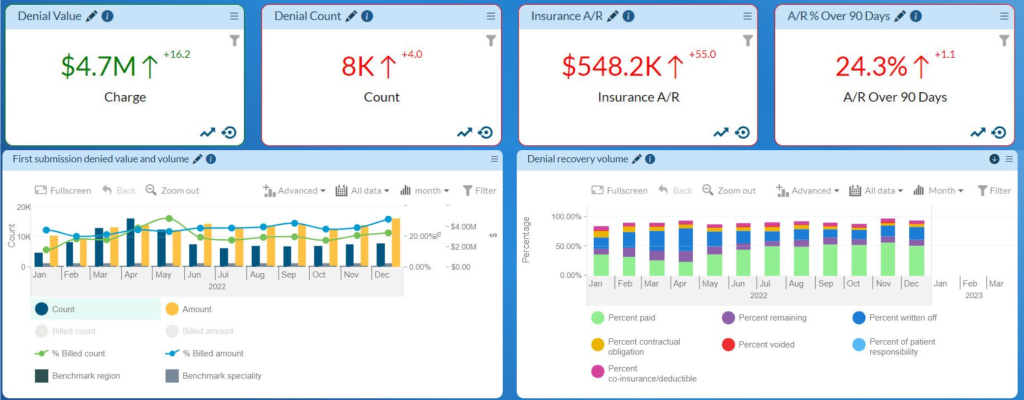
by Carrie Bauman
EHRs are primarily built for clinical workflows and data management, not for tracking financial health. Because of this, EHRs often miss crucial financial KPIs, such as:
Without these KPIs, EHR dashboards provide an incomplete view of revenue cycles, making it challenging for leaders to improve financial health proactively.

AI-powered KPI tracking enables a dynamic view of the revenue cycle, allowing for real-time analysis and swift decision-making:

WhiteSpace Health’s AI-powered KPI tracking isn’t just about automating data collection it’s about transforming raw financial data into strategic insights that healthcare leaders can act on immediately. Here’s how our AI makes the difference:
Healthcare data is often fragmented across multiple systems, making it difficult to get a clear, unified financial picture. WhiteSpace Health’s AI aggregates data from EHRs, billing systems, and payer sources, normalizing it into a standardized format. This eliminates inconsistencies, allowing for a comprehensive and accurate KPI analysis.
Traditional KPI tracking relies on static reports, which can miss crucial trends or irregularities. Our AI continuously scans financial data, detecting anomalies such as sudden spikes in denials, unexpected changes in payment trends, or billing inefficiencies. By identifying these patterns early, healthcare leaders can address issues before they impact revenue.
WhiteSpace Health’s AI doesn’t just track past performance it predicts future trends. By analyzing historical KPI data, our AI models forecast potential cash flow challenges, identify seasonal fluctuations in patient billing, and suggest proactive measures to optimize collections and reduce claim denials.
Denial management is one of the biggest pain points in revenue cycle management. WhiteSpace Health’s AI automatically analyzes denial patterns, pinpoints recurring issues (such as coding errors or payer-specific rejections), and recommends corrective actions. This proactive approach significantly improves denial recovery rates.
Unlike EHR dashboards that provide isolated metrics, our AI-driven platform benchmarks your KPIs against industry standards, peer organizations, and historical performance. This comparative analysis helps healthcare leaders understand where they stand and what actions they can take to improve financial outcomes.
Interpreting complex KPI data can be overwhelming. WhiteSpace Health’s AI uses NLP to translate raw financial metrics into clear, actionable insights. Instead of navigating spreadsheets, users receive intuitive reports and recommendations in plain language, allowing for faster, data-driven decision-making.
Beyond tracking KPIs, WhiteSpace Health’s AI streamlines revenue cycle operations. It can trigger automated workflows for claim resubmissions, suggest optimal billing strategies, and even provide alerts when financial performance deviates from expected trends.
By embedding AI at every stage of KPI tracking from data collection to actionable insights WhiteSpace Health delivers a level of financial intelligence that EHR dashboards simply can’t match.
EHR dashboards, while integral to managing clinical workflows, often fall short when it comes to comprehensive revenue cycle management. WhiteSpace Health Platform’s AI-powered KPI tracking fills these gaps, providing a dynamic, real-time view of your financial health. By tracking key revenue cycle KPIs from billing and payments to denials management and patient responsibilities WhiteSpace Health empowers healthcare leaders to make proactive, data-driven decisions.


2424 North Federal Highway, Suite 205
Boca Raton, FL 33431